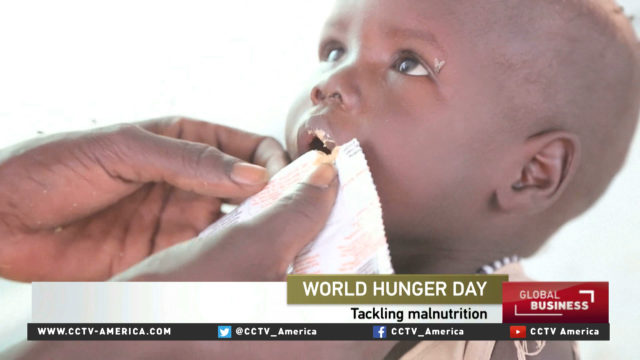When we hear about hunger around the world, we usually think about famine in Ethiopia, or food shortages in war-torn countries like South Sudan and Yemen. Rarely do we think of hunger as a problem in developed nations like the United States.
New York correspondent Liling Tan reports, hunger is also a very real and acute problem the United States.

World Hunger Day is May 28, 2016. Click here to find out more about how you can help tackle the problem. Twitter:@WorldHungerDay

Data: “The State of Food Insecurity in the World,” fao.org. See pages 44-45 for the countries that make up each subsection. Note that since Northern African countries have had hunger rates of less than 5 percent since 1990, their rates are too low to appear on the chart.
Ethiopia, South Sudan and Yemen are countries struck by extreme weather, civil unrest, or both. And their people suffer from extreme hunger.
But in America peace reigns, the weather delivers, and the land provides. But still one in every six Americans still goes hungry.
“Forty-eight million Americans, including 16 million American children live in homes that can’t afford enough food. Now hunger in America isn’t like hunger in parts of South Asia or Haiti or North Korea. It’s not people starving on the streets. But it is people choosing between food and rent, people choosing between food and healthcare, feeding their children and going without food themselves,” Joel Berg, CEO of Hunger Free America said.
The figures don’t include the homeless, just working families who can’t afford enough money to feed themselves
Hunger Free America says the U.S. has the highest level of food insecurity out of any industrialized western nation, even though it’s among the top food-producing countries in the world.
And nowhere is the dichotomy between those who have and those who don’t more evident than in New York City, where a lunch can set you back $30 for a casual take-out, or $300 for a fancy restaurant.
Barbara Hart lives in Staten Island with three children and a grandson. And making sure everyone eats three square meals a day, every day is a challenge even though she receives food stamps.
“Sometimes I have difficulty towards the end of the month and the food doesn’t last throughout the whole month, so I go to pantries and get whatever they can provide. And I borrow money from my friends or family, you know, in case I need flour or oil or sugar, or whatever it is, onions, whatever it is,” Barbara Hart said.
And it’s soup kitchens and food pantries that help fill the void, offering free meals and groceries, often with no questions asked.
“Here in New York City we have a population of over 8 million people and 1.4 million are relying on food pantries and food kitchens,” Triada Stampas, VP for Research and Public Affairs, Food Bank for New York City said.
Food Bank for New York City is a major supplier to soup kitchens and pantries, drawing on donations to provide for more than 63 million meals a year. And they say the need has kept on growing.
Housing costs is the big culprit in a city where rent can account for more than half a person’s income.
“A lot of elites, a lot of people with money scratch their heads and go ‘Oh how can there be hunger, how can there be poverty in a city as wealthy as New York?’ And they just don’t do the basic math. It’s not about behavior, it’s about people not earning enough to buy rent and pay food,” Berg said.
To address this, New York is slowly raising its minimum wage from $9 an hour to $15 over the next several years.
But critics say stronger policies are needed here and across the country to narrow a gap that has been so hard to stomach.
CCTV’s Rachelle Akuffo spoke with two experts from End World Hunger 2030 about some of the challenges to solving world hunger.
She spoke with Todd Evans Founding Director, End World Hunger 2030 and Cathy Webber Program Coordinator, End World Hunger 2030.

Sortable table: Percent undernourished
Note: There is no data for Taiwan. The U.N. noted any percent below 5 as >5, which have been changed to 4.9 here for comparison purposes. Therefore any figure marked 4.9 could represent 4.9 – 0 percent.
Africa
For countries monitored in Africa, the number of hungry people overall increased by 23 percent, from 182 million in 1990-92 to 224 million in 2014-16. Breaking it down by regions, sub-Saharan Africa increased 25 percent while northern Africa decreased by 33 percent over the same time frame.

Asia
According to the report, changes in large populous countries, notably China and India, played a large part in explaining the overall hunger reduction trends in the developing regions.
“Rapid progress was achieved during the 1990s, when the developing regions as a whole experienced a steady decline in both the number of undernourished and the percent of undernourished,” the report said.
Countries in southeast Asia had the most improvement across Asia, showing a 55 percent decrease hungry people. Meanwhile hunger in East Asia decreased by just over 50 percent, while hunger in the central Asia/Caucasus region decreased by 40 percent, and hunger in south Asia decreased by 3.6 percent. But the number of undernourished people in western Asia, which includes Iraq, Lebanon, and Yemen — increased 137 percent, more than doubling from 8 million to 19 million.

Latin America and the Caribbean
The number of undernourished people in Central and South America was cut nearly in half, from 66 million in 1990-1992 to 34 million in 2014-2016.

 CGTN America
CGTN America

